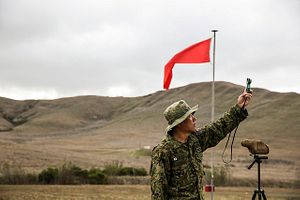Yonaguni, the only town on Yonagunijima – an island under the jurisdiction of Okinawa Prefecture – held a referendum on February 22 regarding the central government’s plan to deploy a Self-Defense Forces unit to the island. In the referendum, 60 percent of those who voted supported the deployment – pleasing both the mayor of Yonaguni and the central government.
Those who voted in support of the plan believe that Nansei Islands need stronger defenses. They also hope that the influx of troops and their family members will help revitalize the local economy. The SDF unit is expected to comprise about 150 troops for coastal observation purposes.
Yonaguni Mayor Shukichi Hokama said he was “relieved by the results” of the referendum. He added, “We would like to run our administration by collaborating with the Defense Ministry.”
With regards to the planned base, Defense Minister Gen Nakatani said in a statement that “the construction work is already in progress, and we will follow our plans steadily to establish the unit by the end of fiscal 2015.” The unit, which will be primarily responsible for monitoring boats and planes traveling in the vicinity, is part of the Japan’s overall efforts to strengthen defense of Nansei Islands in response to China’s increased maritime activities. As a senior Defense Ministry official said, “Having Self-Defense Forces on the island, which lies on the westernmost edge of Japan, would be the best deterrent,” especially in times of uncertainty and rapid geopolitical change.
The deployment of troops on this island, situated 500km away from the main Okinawa island, 110km away from Taiwan, and 150km away from the disputed Senkaku/Diaoyu Islands, has been a political issue in Yonaguni for several years now. Yonaguni had reached out to the Defense Ministry in 2009, hoping that having troops stationed on the island could help slow depopulation and revive the economy. The central government decided on the deployment in 2011, and Hokoma won his second mayoral election in August 2013 by 47 votes after running on a pro-deployment campaign. Construction of facilities began last spring. However, when opposition party members won three of the six seats in the town assembly last September, they submitted a local referendum vote to decide the issue.
Opponents of the coastal monitoring unit are concerned about the negative health effects from the sentry radar’s electromagnetic waves, as well as becoming a target of attack if a military contingency arises. There are also concerns that an influx of new, presumably conservative residents – who would together make up 10 percent of the island’s current population – could sway the island’s political future. Opposing groups appear to be planning to file a lawsuit for an injunction to halt construction of facilities.
The use of a referendum has been criticized, with detractors arguing the deployment of troops to Yonagunijima is not simply a local issue but an issue that affects national defense policy. Though the referendum is not legally binding, Hokama had promised to respect the outcome and “take an uncooperative stance” on troop deployment should the majority reject it.
However, the outcome ultimately supported the central government’s plans.
Of Yonaguni’s 1,276 eligible voters, 1,094 voted, about an 86 percent turnout rate. Voting rights were given to 97 minors in junior high school or older and five permanent foreign residents.

































